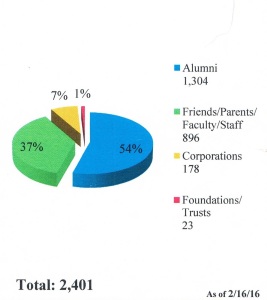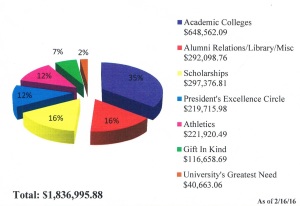
The $ 100 million university budget when it comes right down to it it is built on three main sources and revenue: state appropriations, tuition and fees, and fits/ grants.
Outside the annual budget, administrators also maintain an additional $70 million–the university’s endowment, money that often comes from large donations.
Through it, donors, including alumni, friends, parents, faculty, staff, corporations and trust foundations, including buildings like the Dillard College of Business Administration Building and expansions such as the one to McCoy Engineering Hall. Historically, families with ties to the oil and gas industry, including the family of Hollis R. and Donna Sullivan, have been the school’s largest donors.
Sullivan started his own oil company Hollis R. Sullivan, Inc. in 1990 and later donated $1 million to MSU athletics, the largest gift received in the history of the MSU athletics program.
Howard Farrell, vice president for university advancement and student affairs, said most of the school’s big donors are associated with the oil and gas industry.
“The over amount of big dollars and I mean the big dollars that the school receives — the $5, $6, and $7 million donors — are really connected to the oil and gas industry,” Farrell said. “No surprise there. A lot of it is old money and I mean it in a good way because it’s businesses that have been in the industry for decades.”
More recently, however, the oil and gas industry has had to lay off more than 200,000 employees and the number continues to rise, according to the Houston Chronicle.
Farrell continued. “It’s no surprise to anyone how depressed the oil and gas industry is. Has it affected us? You bet it has. Will it affect us forever? No. Texas goes up and down. We have donors from every state. We have international students that come here.”

Farrell said people in the community are donating money because they believe in the vision that MSU has for the university.
“It’s not that our donors were all Midwestern graduates, but they really feel good about the vision of the university other communities would kill to have a first class university amongst their midst. They really liked what we were doing they felt connected to the institution.”
And while university officials still depend on memorable donors Farrell, who is retiring in August said he is continually seeking new donors. The new residence hall available is for new donors who would like to put their names on a part of the new addition to MSU. It is a continuous cycle for MSU to connect to people.
Farrell said he is even looking for donors for the mass communication building that’s under construction.
“We’re in the process right now of getting people to donate to the new residence hall naming halls of these people. It never ends, that’s the beauty of it. I’m always out talking to people. We spend a lot of time of informing people of who we are. We are trying to find someone right now to put their name on the Wichitan structure.”
Suzanne Shipley, president of MSU, said the retirement of Farrell will have an effect on the school because of the connections he has made with people.
“Every loss effects the school and Howards been the face of Midwestern for quite a while and I think he will continue to be because he really loves this university. I think the challenge will be to gain the greatest depth of understanding of donors we can as a team and call Howard when we need him and say, Howard help us out, but I think you have turn over in places you have changes and people move on and you adjust. It all depends on who replaces him whether we find somebody from this area that comes and knows this people or we find someone from outside the area that knows development.”
Farrell said MSU has even gone as far as trying to get into contact with Dr. Phil, a notable former student, to donate to the university.
“We want to identify people who have a love for what they do. We reached out to Dr. Phil to try and put his name on a psychology clinic. Did it work? No, but unless you try you never know. You constantly have to go out there.”
One way for university officials to keep in touch with its graduates is by having them fill out alumni relations cards during Imagine Graduation. Contacting alumni and potential donors is an effort that has developed and continues to develop.
Farrell said down the road he hopes that the contribution from alumni and friends of the university will increase.
“We have a parent fund. We call thousands of alumni and friends from the university. It’s a very organized effort that has developed and continues to develop. As time goes on those who give $20 today, five years it may be $200 and in 10 years might be $2,000 as people advance in business. So far it has been very successful.”
Although there is no guarantee that donors such as Fain, Dillard, and McCoy will continue to contribute, Farrell said the families come from an older generation, that he grew up in, who knew how important education was. He hopes that the same idea passes down through the family tree.
“With the Fain foundation, the mother passed away, but the daughter and the family have continued to donate for decades. I have found that a couple of generations ago there was a real reverence for education. Historically, this country has had a reverence for education. You see a lot of families that hold on to that mantra and the value of education.”
All of the credit is due to people of MSU that help make the university run, said Farrell. “The real credit of all of this goes back to the faculty and staff that create a climate that students prosper in and also the credit goes to people in Wichita Falls and in our extended community and how they choose to get with us and bring us to the next level.”
THE FUTURE OF MSU DONORS
Farrell foresees that the donations will increase. However, the person or people donating the funds decides where the money goes and what the money will be used for.
Laura Peterson, assistant director of university development for donor services and scholarships explained where the money goes. “Well our
donors decide where the money goes. So if someone donates to chemistry scholarships or something like that, that’s where it goes.”
MSU also receives funding from the state, about $26 million in state appropriations.
However, as Peterson said MSU cannot just count on state money.
“Our donors are vital. We are a state university, but our appropriations from the state continue to drop and so that support from donors is more and more important every single year.”
With donors having the power to assign where their money goes some departments get a lot more donations and funding than others.

Farrell said, “It’s the overwhelming amount of time the donor gives to his or her love, whether it be mass communication, engineering, psychology. Unrestricted money is different. Someone can say here’s a million dollars do whatever you want. Does chemistry get that type of support? No. Does the English department? No, but there are still people who give for scholarships and stuff.
The money that departments receive is vital because it provides new programs and accreditation said Farrell.
“The money has allowed us to provide great programs to the students of MSU. For example, the new petroleum engineering program that was developed. Also, Dillard has international accreditation. Less than thirteen percent of the colleges in the world have that accreditation.”
Not all donations come with a list of restrictions, said Peterson.
“As far as unrestricted gifts go, there are few donations that we get that are unrestricted and those are handled at a higher level with the vice presidents and presidents as far as how that divvied up.”
Peterson said unrestricted donations are hard to come by. “Most of the donors designate where they want their money to go.”
NEW PROJECTS
MSU is undergoing only two new projects and additions to improve the campus and the education students receive.
One example, is the new ‘A’ wing addition to the Fain Fine Arts building.
Farrell said, “We’re trying very hard right now to raise money for the mass communication addition and we have some people who are interest in that because they were mass communication students.”
With some departments in need of funding, MSU has to find different ways to approach potential donors for their funding. Peterson explained her process in the donor services building.
“Me, personally, I don’t go out and seek. Generally the donors that I deal with are people that that already know they want to donate and they’re looking at getting something set up. We do have other areas in university development that do go out and seek out the donations, whether it’s our annual fund campaign where were writing to alumni and friends asking for support, or targeting certain donor, but in this particular office, no we do not go out searching for them.”
Farrell said Harvard, which has an endowment of $34.6 billion, is a great model.
“We’re focused on helping our graduates. What makes Harvard such a great school? The graduates. That’s the type of approach we’re trying to take. People come and go but the university will always be here. People always give to successful universities.”
Total Endowment
(source: Board of Regents meeting packet)
- 2012-2013 | $63,582,196
- 2013-204| $ 73,514,557
- 2014-2015| $ 68,154,607
- 2018-2019 (goal) | $80,087,716
Top 10 University Donors
(source: Howard Farrell)
- Kay Dillard
- James N. McCoy
- Robert D. Gunn
- Billie D. McAda
- Aurora Bolin
- Alfred B. Guinn
- Peggy Kimbell
- Beverly W. Bolin
- Hollis R. Sullivan
- Peyton S. Carnes
Additional reporting: Hunter Porter, Jacklyn York and Harley Warrick














